The objective of this project was to create an ecosystem of swimming jellyfish robots that could actuate soft tentacles underwater to produce movement. In terms of an artistic vision, we wanted to create a peaceful and calming piece. We aimed to create two types of jellyfish: one jellyfish that is fully actuated with 3 independently moving legs, and one jellyfish that has a single actuator and moves by catching the current. By showing these two jellyfish together, we can draw contrast to their differing modes of movement; one jellyfish being self-sufficient and the other depending on the water’s movement.
The fully actuated jellyfish represents an interpretation of bio-mimetic robots where the form of the robot closely resembles the structure of natural organisms, but the functionality is much more complex. The goal of the single actuator jellyfish was to produce a soft robot that mimics both the form and function of jellyfish in nature, which primarily ride ocean currents for locomotion with minimal intervention through movement.
Creative Design Opportunities
We used molded soft silicone to make the jellyfish. The soft material allowed for each leg to be flexible. The soft material allowed channels to expand when filled with water, which caused a leg to bend. The soft material also meant that the jellyfishes would be gently moved and rippled by the water currents, and give the effect of floating.
Outcomes
We successfully designed and fabricated two jellyfish.
The biggest success was the pronounced movement of the jellyfish legs of the 3-legged jellyfish. The motor pump combined with the small water channels allowed for a very significant bend in the legs. Furthermore, we were able to refine our molding and bonding process to produce a final jellyfish without air leaks or accidentally sealed channels. We adopted design elements and techniques from the JenniFish paper cited below. We created a two part mold for the top piece of the jellyfish, which was bonded to a thin bottom flap. We used clamps to ensure a tight fit for the two part mold which prevented leaks.
Areas of improvement include the buoyancy and displacement of the jellyfish. The silicone molded part is too heavy to float once the inside is filled with water. We added a balloon to compensate for the buoyancy so that the jellyfish would be more neutral with the water and float. However, it was difficult to get the inflation of the balloon perfectly so that the jellyfish would float suspended in the water instead of either sink down or bob to the top of the water. Furthermore, we had hoped motions like pulsing would create more vertical motion such that successive pulses would allow the jellyfish to swim up with a significant displacement from the starting position. However, the jellyfish mostly stayed in place. For the 2-legged motion, we did see noticeable horizontal displacement and the jellyfish was propelled in the direction of the non-actuated leg. Thus, we assume that the problem with vertical displacement is related to the buoyancy issue described earlier.
In addition, the single-actuator “passive” jellyfish could have had a more distinct movement. There were a few air leaks in the legs, and the flap was slightly too thick, making it difficult for the thin legs to bend it.
Video
Citations
Frame, Jenny. “Self-contained soft robotic jellyfish with water-filled bending actuators and positional feedback control.” (2016). https://fau.digital.flvc.org/islandora/object/fau%3A33675/datastream/OBJ/view/Self-Contained_Soft_Robotic_Jellyfish_with_Water-Filled_Bending_Actuators_and_Positional_Feedback_Control.pdf
Frame, Jennifer & Lopez, Nick & Curet, Oscar & Engeberg, Erik. (2018). Thrust force characterization of free-swimming soft robotic jellyfish. Bioinspiration & Biomimetics. 13. 064001. 10.1088/1748-3190/aadcb3.
Chai, Katie. Soft Robotic Jellyfish, Instructables. https://www.instructables.com/Soft-Robotic-Jellyfish/
Technical Documentation
Fully Actuated Jellyfish
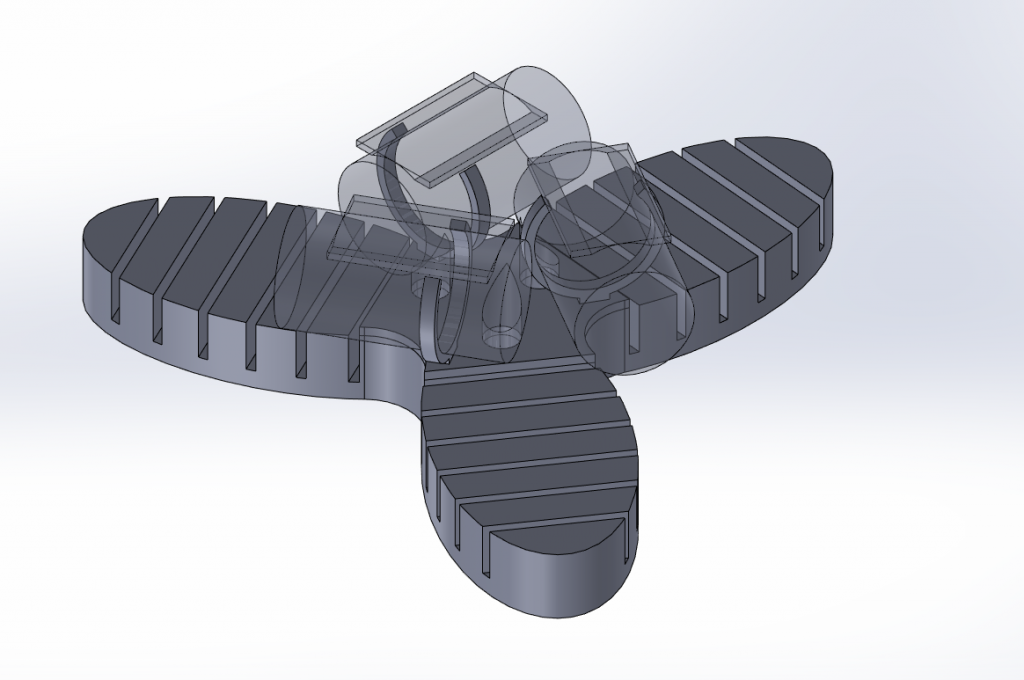
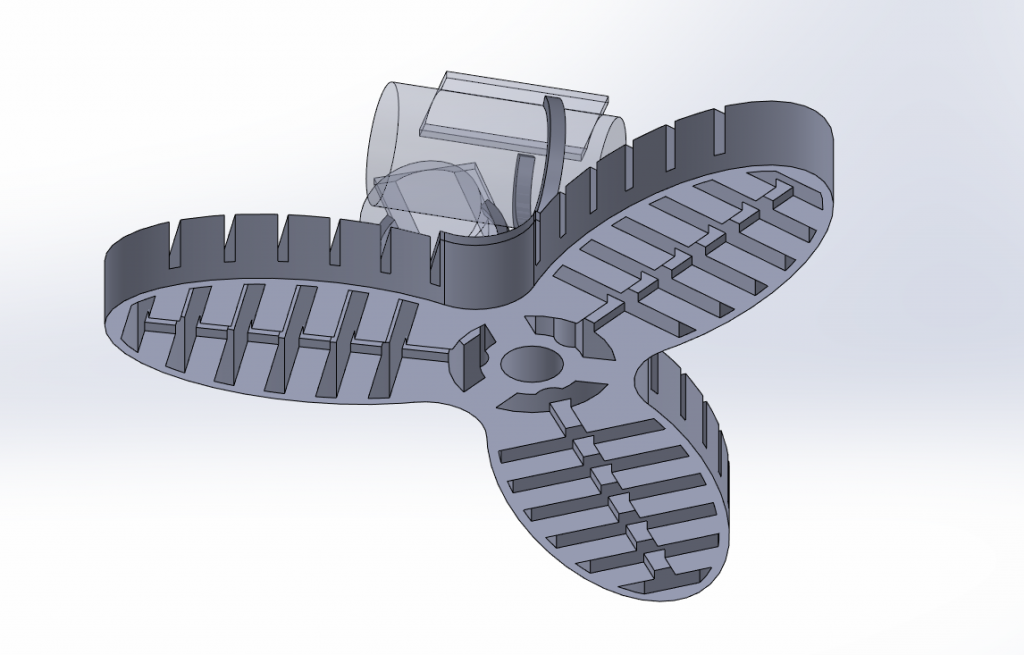
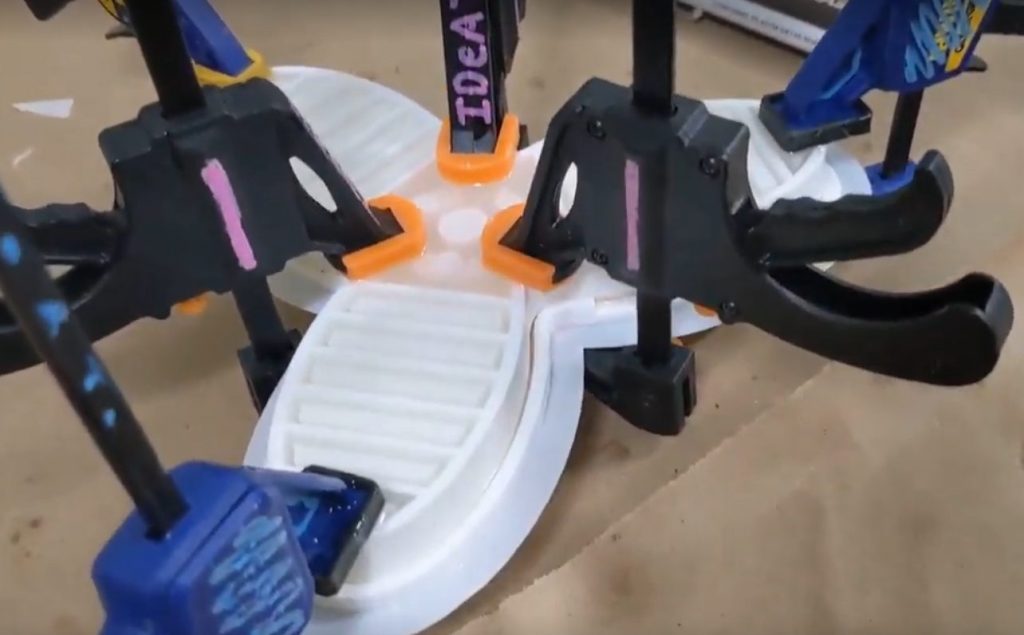
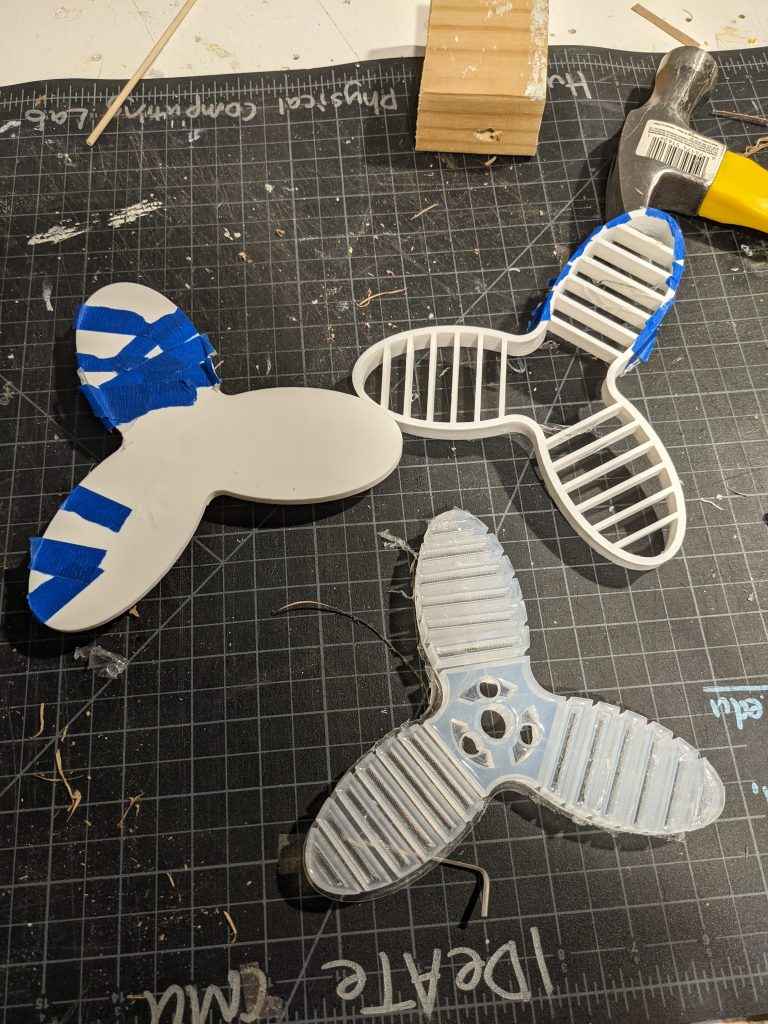
Passive Jellyfish
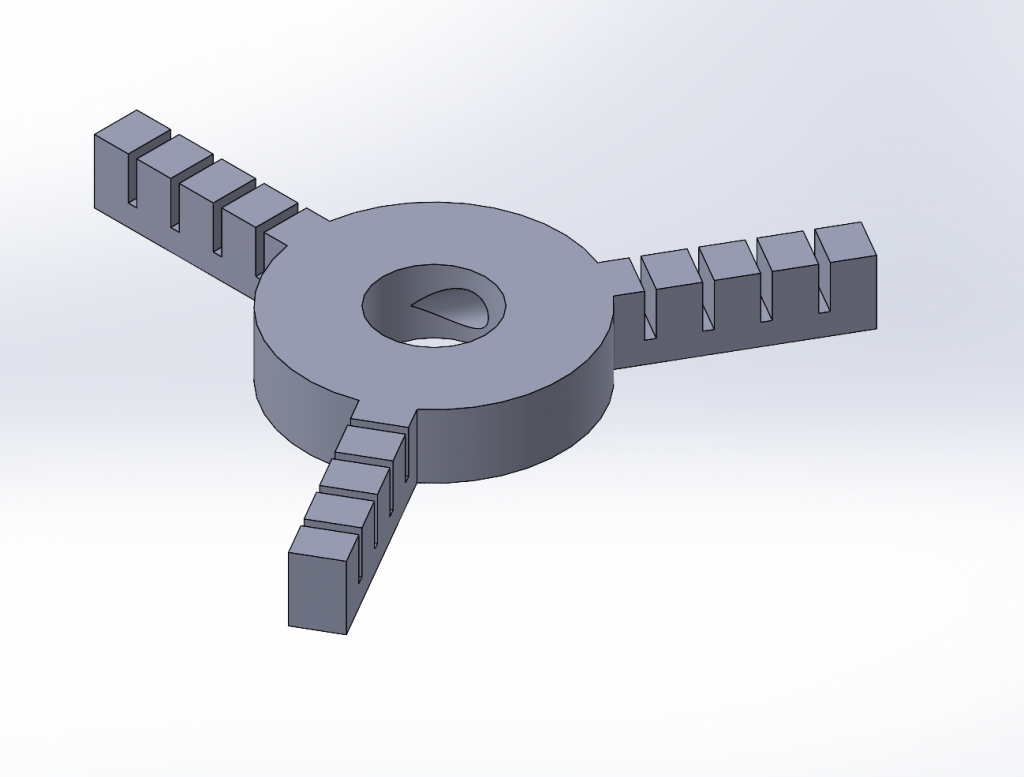
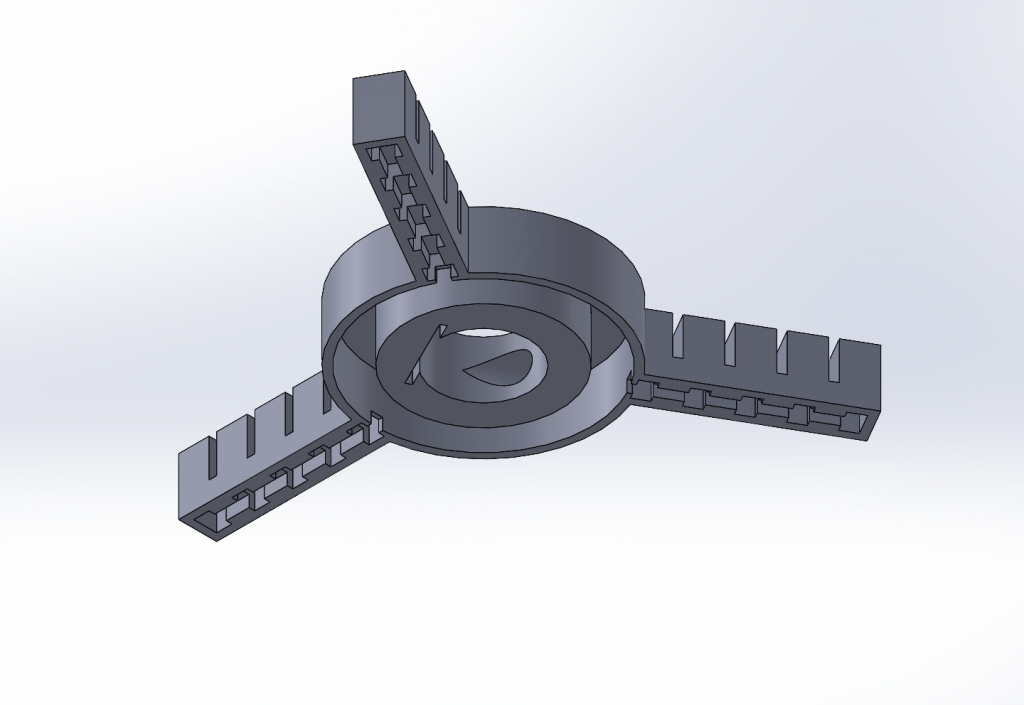

CAD
Drive Link: https://drive.google.com/drive/folders/1uOuozLeJPmjkVByYSKEhGGOgxZAxN89-?usp=sharing
Contents
Hand Pump Test: model of a single actuated tentacle with a hand pump
Tension Wire Test Arm: Wire driven, manually actuated tentacle
Tension Wire 2: Second iteration of tension wired tentacle
Jasmine Jellyfish: First design for full jellyfish with 3 tentacles and one pump
Jellyfish 2.0: Second and final design of 3 tentacle jellyfish with independent tentacle actuation via 3 pumps
Smol jellyfish: Passive, single pump large flap jellyfish
Source Code
https://drive.google.com/file/d/13dDZ4bJURZZgL-e9u6N5yBAhruQPjPO6/view?usp=sharing
Contributions
Both partners worked on both jellyfish design and fabrication fairly equally. Jasmine wrote the code.
]]>We also made a CAD model for a smaller single actuator jellyfish. But not sure if we can get it done in time for the show.
Video: https://drive.google.com/file/d/1TEdhAqjEpIGa3L61PbP-pYjLCAwTackj/view?usp=sharing
The next steps are to clean up the wiring, code some more motions, and finalize our piece.
For control, we directly powered the motors with the 5 volt power source. Next week we intend to use the Pico to individually actuate each motor. However, we need another motor controller chip since each chip only has 2 channels.

This week we were able to successfully integrate 1 motor pump into the body of the jellyfish. We desired the mold to allow for 3 motor pumps to be attached, one on each tentacle of the jellyfish. However, during the bonding process, 2 of the air channels from the motor pump to the tentacles got covered in silicone and accidentally sealed. Therefore, we were only able to test the actuation with a motor pump with one tentacle. However, we did some post-processing to attempt to fix the 2 sealed tentacles, which will hopefully bond and we can test them tomorrow. A notable success this week was the ability to demold the jellyfish without breaking the bottom piece of the 2 piece mold.
Videos and Photos

Objectives for this week
- Update the tentacle shape to prevent inflating and cause bending.
- Create new mold, and fabricate the new jellyfish
- Test the new jellyfish in the tank
- Stretch goal: test with pneumatic system
Summary of Week Results
We created a new jellyfish tentacle design that had smaller cavities and air channel so that when air flows, it pushes the top of the tentacle outward so that the overall tentacle bows. The jellyfish will be formed from a top piece with all the cavities/complicated geometry and a bottom thin and flat flap.

What worked well: using fabric to make the bottom flap stiffer, the 2 part mold for the top and the flap for the bottom, was able to get noticeable curvature change in each tentacle
What can be improved: middle ring should have thicker walls, attachment of tube to mold should be stronger
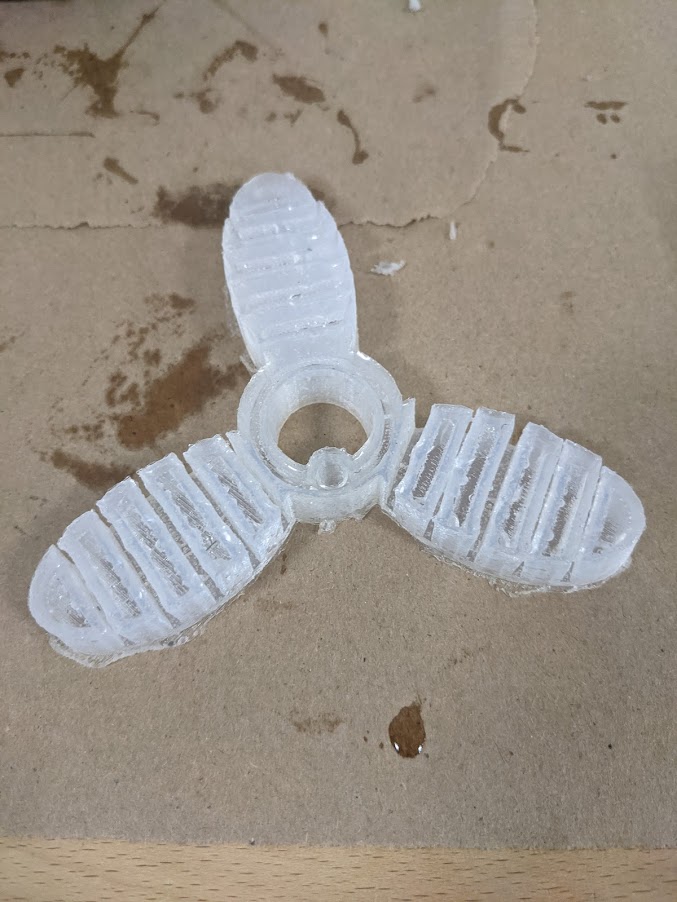
Objectives for next week
- Create a new jellyfish that uses the hydraulic pump
- Wire and test it in the fish tank
Video:
CAD Rendering:

CAD Files:
https://drive.google.com/file/d/1TGqI7yrN6cTSvNmngbLCl3iYh9cUARKO/view?usp=sharing
]]>
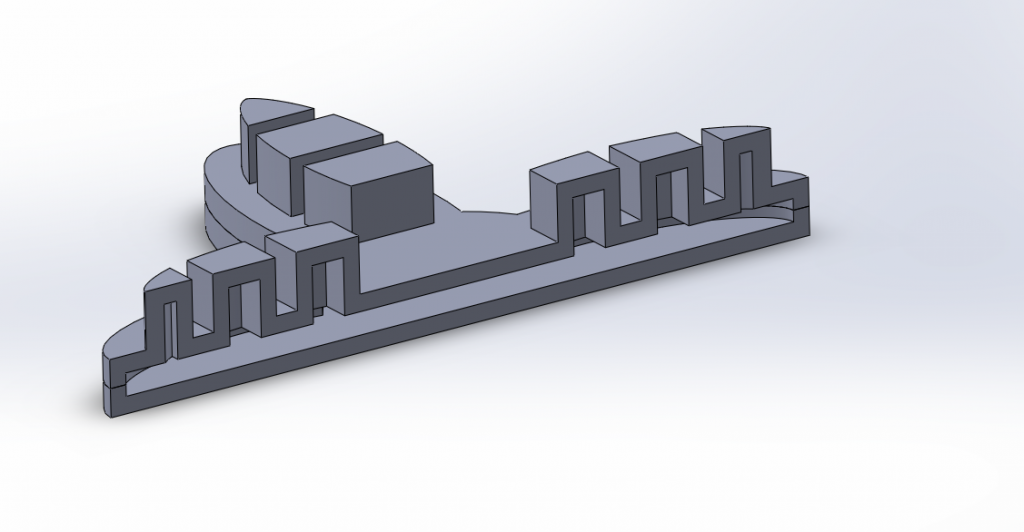
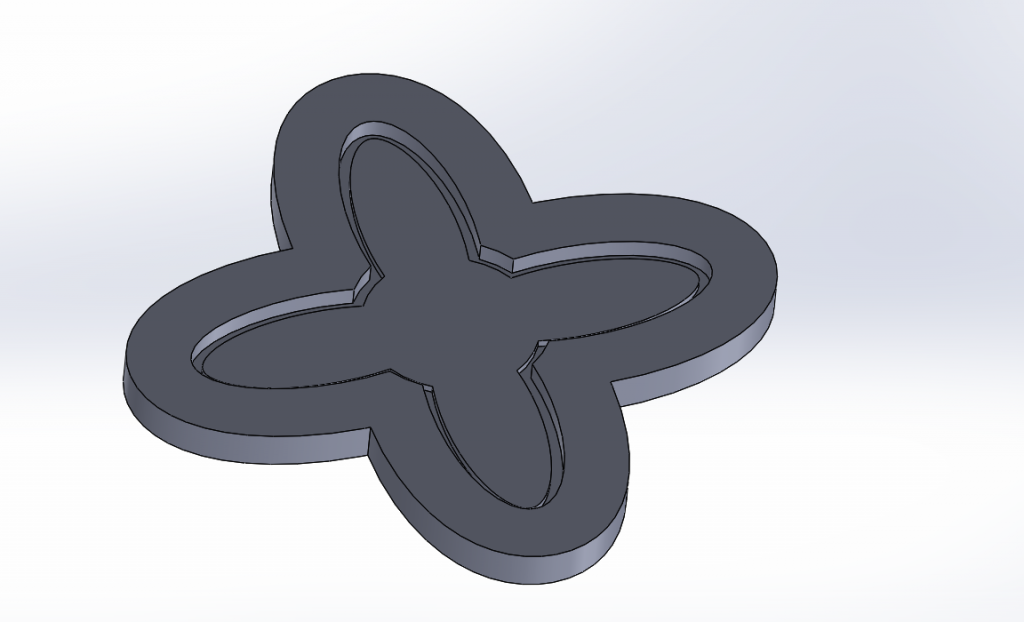


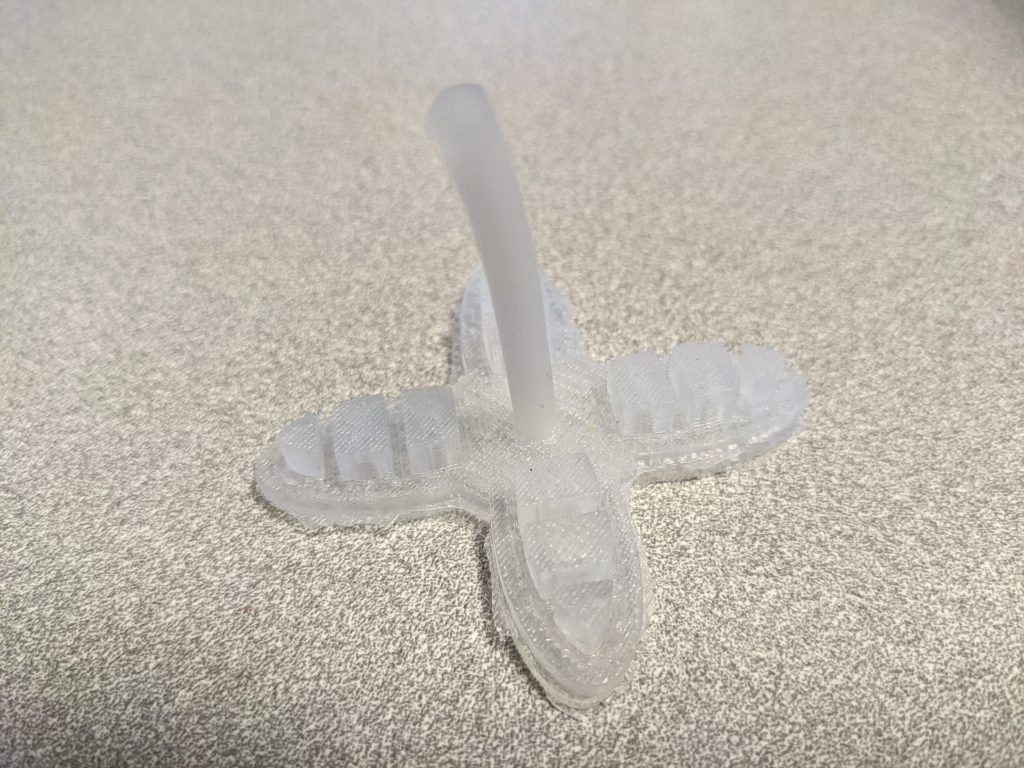
Volume of part: 7084.63 cubic millimeters
]]>1. Silicone Molding Practice

2. Actuation Mechanism Testing
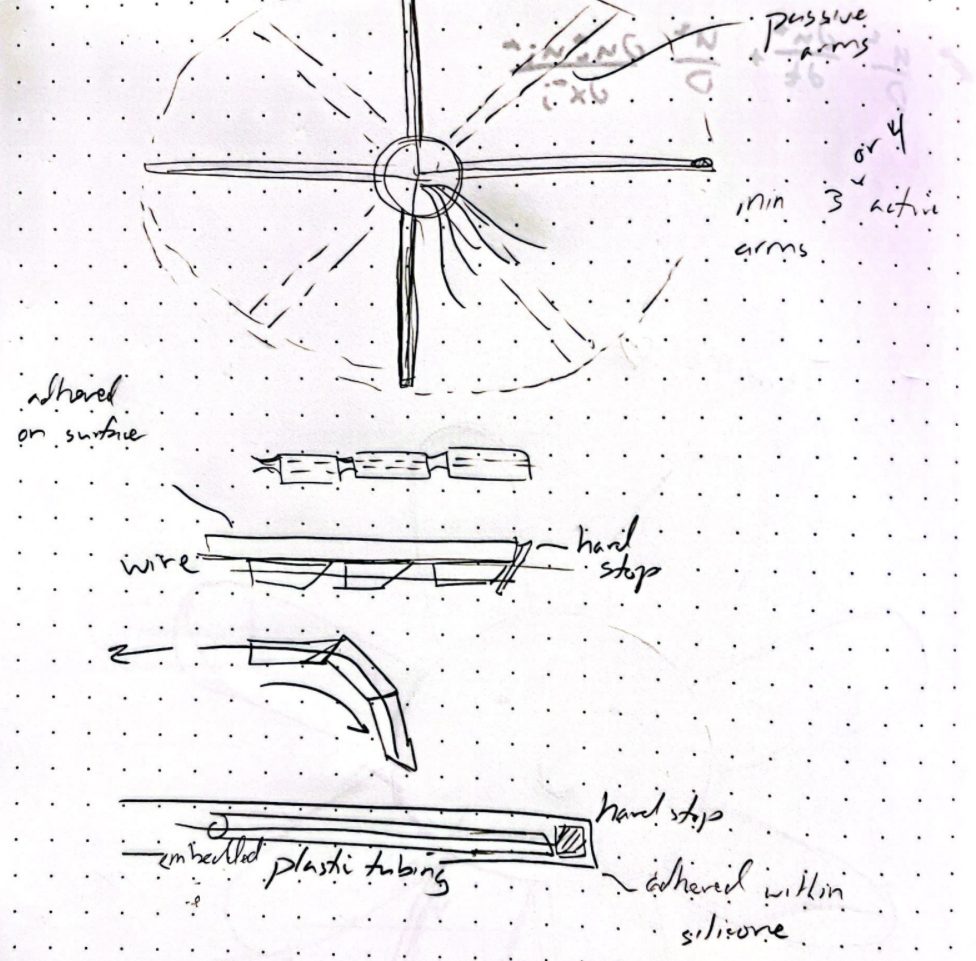
Materials:
Near clear Ecoflex Silicone
Ecoflex 00-30
Waterproof coating (XTC-30)
Fish tank
Mini Submersible Water Pump DC 3-6V 120L/H
Hobby Servo
Tubing
Pneumatic pumps
Hand pump
Joint Bibliography:
https://www.instructables.com/Soft-Robotic-Jellyfish/
L. Hines, K. Petersen, G. Z. Lum, and M. Sitti, “Soft Actuators for Small-Scale Robotics,” Advanced Materials, vol. 29, no. 13, p. 1603483, 2017, doi: 10.1002/adma.201603483.
]]>https://drive.google.com/file/d/1XCO9WWDMAYbIDKoVfZ8EF5DDniAaOMA4/view?usp=sharing

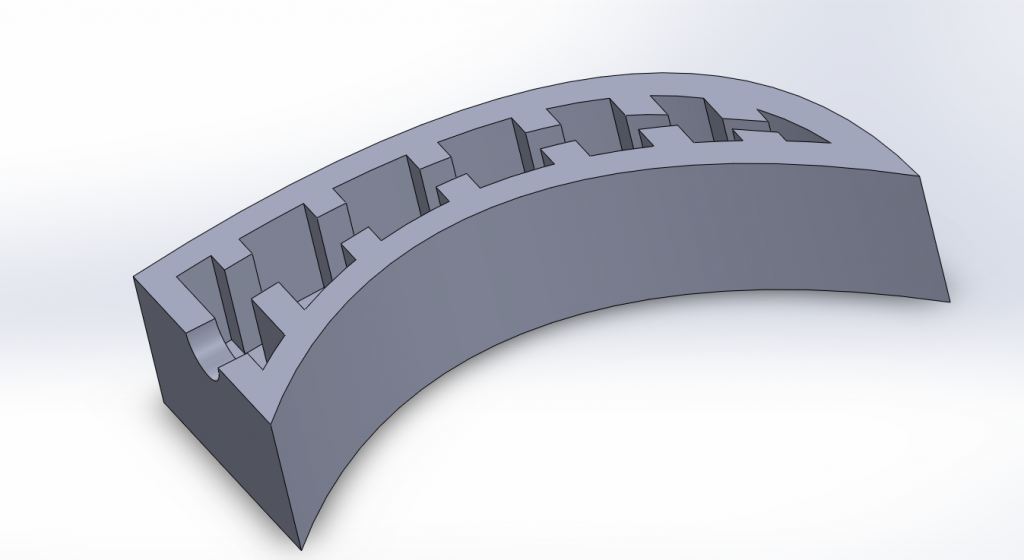
The project idea is a swimming robotic jellyfish, that would be propelled by the motion of its body and legs contracting. The jellyfish would be mostly constructed of soft silicon materials, with either pneumatic or hydraulic actuators installed to create motion. If a pneumatic system is used, the components of the pneumatic system could be installed outside the tank and have air tubes running into the jellyfish robot in the tank to reduce size/weight. The artistic motivation is to mimic a creature found in nature, but also to choreograph a series of movements for the robot that a natural animal would not perform.
Creative Requirements
Satisfying creative goals may require more interrogation of the essential idea. At this point, more specificity will help focus the process. So please think carefully about the following prompts, considering that not all will apply to your specific idea:
• What are the essential movements?
The essential movement is for the jellyfish to be able to swim up and down. This would be the MVP. Other movements include spinning, turning (left or right while still swimming in the upward direction), and flips.
• What is the tempo, pace, or speed for each movement?
For swimming up and down, the speed would be slow, matching the speed of a natural jellyfish. Turning would also be a slow movement. For spinning, I imagine the jellyfish to spin relatively quickly, for example making 5 rotations a second. For the flip, the movement would be medium speed, with the duration of the flip lasting a couple of seconds.
• How many control channels are needed?
I believe at least 3 control channels are needed. 1 control channel is needed to open and close the tentacles to create upward thrust. 2 control channels which could be propellers or pumps placed radially would be used for turning and spinning maneuvers. I’m not sure how to technically make the jellyfish flip or where to place actuators to make that happen.

• What is the overall size or scale?
The size would be pretty small for the actual jellyfish, although we probably need a large enough tank for it to have space to do its movements. The jellyfish will be around the size of 1-2 hands.
• What is visual design language?
The visual design language would be to mimic the form and color/texture of a real jellyfish. Jellyfish have a translucent, soft, alien like quality, and are associated with the idea of glowing.
• What specific materials, colors, or textures are essential to convey the idea?
I believe the silicone used for the jellyfish should be a translucent white color. The convey the idea of glowing, we could have the tank lit with LEDs that would project onto the surface of the jellyfish.
You may find in the course of your thinking that you wish to revise your project premise. This is perfectly fine, but please pause and write a new carefully revised project statement. In your write up, please identify the specific insight which led to the revision.
Technical Critical Path
The critical path is the longest chain of essential milestones in a project plan, representing the rate-limiting sequence of goals. In a research project, the plan is always contingent since unknown problems or discoveries may trigger a significant pivot. Please note the constrast to a development project which seeks an efficient path using well-understood processes to achieve a goal reliably.
So please think carefully about the following prompts, considering that not all will apply to your specific idea:
• What is the simplest version of the system which can address the creative goals?
The simplest version of the system is a simple hand-pump actuated jellyfish like the one built in this video:
https://courses.ideate.cmu.edu/16-480/s2022/ref/text/video/misc.html#jono-sanders
This could address the goals of making a simple jellyfish to mimic the real creature. However, it is very simple in terms of control, so ideally we could add actuators to it and make it freely swimming.
• What are all the components of the overall system? E.g. this may include elements of structure, actuation, power, sensing, computation, algorithm.
Structure: silicone molded body
Actuation: Needs to be able to generate thrust and spin.
Sensing: an accelerometer or IMU could be used for closed loop feedback controls. Also, a touch sensor could allow the jellyfish to change directions when it hits a wall
Computation: generate the actuator control to create desired movement.
• Are there rigid or mechanical parts in addition to soft materials?
Yes, we will need to use pumps.
• Which specific components will be hardest to fabricate? What specific techniques might be included?
I think getting the silicone body to mold correctly will be the hardest to fabricate. Some specific techniques including 3d printing the mold, pouring in the correct ratios of silicone mix and degassing.
• Which specific components will be hardest to design? What specific design methodology will be needed?
The hardest components to design will be the actuators that make the jellyfish spin or do more complex movement. I can look into how this is done for underwater vehicles such as submarines.
Proof-of-concept
With that in mind, please choose the most productive first step toward realizing the system, and describe the first proof-of-concept experiment you could run.
• What is the goal?
The goal of the initial test is to figure out the casting process and make some simple initial movements. I would build a jellyfish similar to Jono Sander’s video that is powered by a simple hand pump.
• What materials or processes are required?
Silicon, 3d mold, casting materials, tubing, hand pump.
• What kind of scaffolding is require to test the result?
The hand pump is the scaffolding, since in the final version, we’d like to use actuators.
References:
https://www.youtube.com/watch?time_continue=10&v=POfT02BIPpY&feature=emb_logo
https://www.youtube.com/watch?v=NxcHxG9LVCQ
https://www.youtube.com/watch?v=ytKzx2Xsukk
Jeongae Bak et al., “Hovering Control of an Underwater Robot with Tilting Thrusters Using the Decomposition and Compensation Method Based on a Redundant Actuation Model,” Robotics and Autonomous Systems 150 (April 1, 2022): 103995, https://doi.org/10.1016/j.robot.2021.103995.
Tao Du et al., “Underwater Soft Robot Modeling and Control With Differentiable Simulation,” IEEE Robotics and Automation Letters 6, no. 3 (July 2021): 4994–5001, https://doi.org/10.1109/LRA.2021.3070305.
Jennifer Frame, Nick Lopez, Oscar Curet, and Erik D. Engeberg. Thrust force characterization of free-swimming soft robotic jellyfish. Bioinspiration and Biomimetics, 2018. doi:10.1088/1748-3190/aadcb3